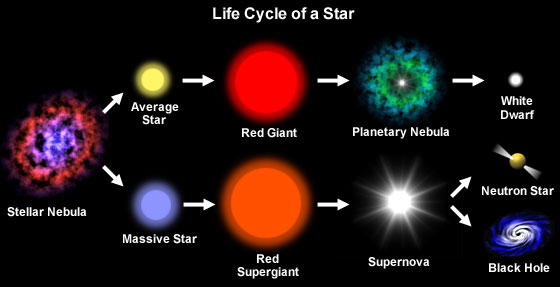Science & Technology
White Dwarf
- 25 Oct 2021
- 5 min read
Why in News
Recently, an international team saw a white dwarf losing its brightness in 30 minutes, which usually takes a period of several days to months.
- This peculiarity in brightness of white dwarfs can be referred to as switch on and off phenomena.
- Using the Hubble Space telescope and Transiting Exoplanet Survey Satellite (TESS), astronomers have identified several white dwarfs over the years.
Key Points
- About White Dwarfs:
- Formation:
- White dwarfs are stars that have burned up all of the hydrogen they once used as nuclear fuel.
- Such stars have very high density.
- A typical white dwarf is half the size of our Sun and has a surface gravity 1,00,000 times that of Earth.
- Stars like our sun fuse hydrogen in their cores into helium through nuclear fusion reactions.
- Fusion in a star's core produces heat and outward pressure (they bloat up as enormous red giants), but this pressure is kept in balance by the inward push of gravity generated by a star's mass.
- When the hydrogen, used as fuel, vanishes and fusion slows, gravity causes the star to collapse in on itself into white dwarfs.
- White dwarfs are stars that have burned up all of the hydrogen they once used as nuclear fuel.
- Black Dwarfs:
- Eventually - over tens or even hundreds of billions of years - a white dwarf cools until it becomes a black dwarf, which emits no energy. Because the universe's oldest stars are only 10 billion to 20 billion years old there are no known black dwarfs.
- It must be noted that not all white dwarfs cool and transform into black dwarfs.
- Chandrasekhar Limit:
- Those white dwarfs which have enough mass reach a level called the Chandrasekhar Limit.
- At this point the pressure at its center becomes so great that the star will detonate in a thermonuclear supernova (explosion).
- Formation:
- Switch on and off Phenomena:
- The white dwarf, which is discussed, is part of a binary system called TW Pictoris, where a star and a white dwarf orbit each other.
- The two objects are so close to each other that the star transfers material to the white dwarf.
- As this material approaches the white dwarf it forms an accretion disk or a disk of gas, plasma, and other particles around it.
- As the accretion disk material slowly sinks closer towards the white dwarf it generally becomes brighter.
- Also there are cases when the donor stars stop feeding the white dwarf disk. However, reasons for this are still not clear.
- When this happens the disk is still bright as it “drains” material that was previously still there.
- It then takes the disk about 1-2 months to drain most of the material.
- However, TW Pictoris' drop in brightness in 30 mins was totally unexpected and it may be due to the process called magnetic gating.
- Magnetic gating happens when the magnetic field is spinning so rapidly around the white Dwarf it creates a barrier disrupting the amount of matter the white dwarf can receive.
- The white dwarf, which is discussed, is part of a binary system called TW Pictoris, where a star and a white dwarf orbit each other.
- Significance: This discovery will help understand the physics behind accretion – how black holes and neutron stars feed material from their nearby stars.
Chandrasekhar Limit
- Chandrasekhar Limit is the maximum mass theoretically possible for a stable white dwarf star.
- A limit which mandates that no white dwarf (a collapsed, degenerate star) can be more massive than about 1.4 times the mass of the Sun.
- Any degenerate object more massive must inevitably collapse into a neutron star or black hole.
- The limit is named after the Nobel laureate Subrahmanyan Chandrasekhar, who first proposed the idea in 1931.
- He was awarded the Nobel Prize in Physics in 1983 for his work on the physical processes involved in the structure and evolution of stars.





